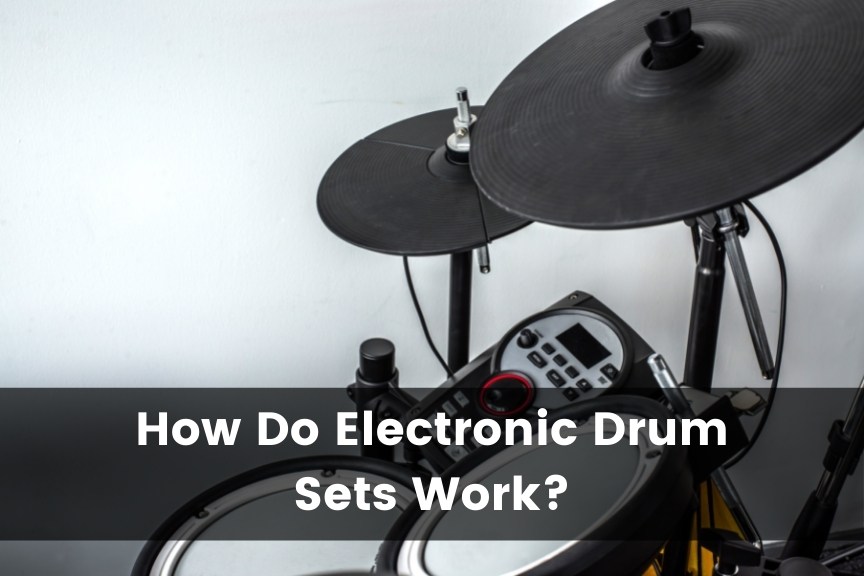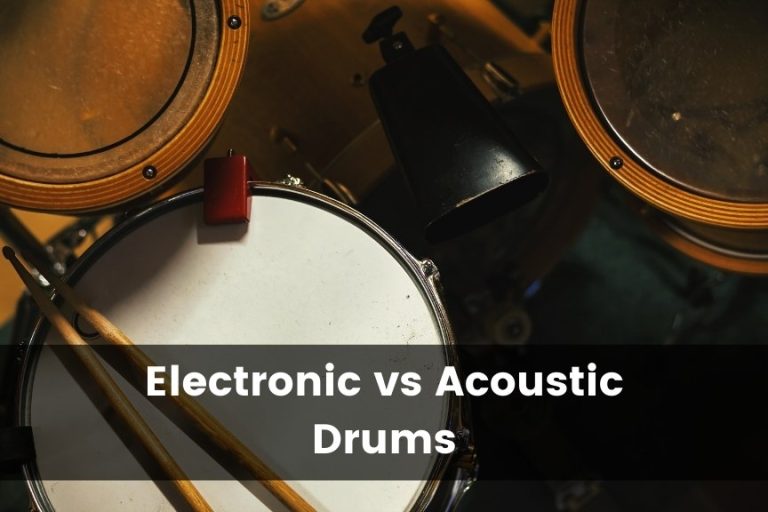How Do Electric Drums Work? Everything You Need to Know
With the evolution of technology, there is now a wide range of options when purchasing a drum kit. Whether you are looking to buy an entry-level model or the latest high-end kit, the options available in the world of electronic drum kits ensure that there will be a product to suit your needs.
An electronic or digital drum kit uses pads and electronic trigger sensors to replace traditional drums and cymbals. Using a drum module, drummers can trigger sounds, sequences, and various types of percussion on the electronic drum kit and then amplify those sounds.
Electric drums or standalone drum machines are becoming more and more popular as a tool for recording and producing music. They’re used in many styles of music, from hip-hop, metal, punk, and rock. But before we look at what electric drums can do for you, let’s look at the anatomy of an electronic drum kit to see how they work.
The Anatomy of Electronic Drums
Electronic drums have been a popular instrument for some time and have become more advanced as technology continues to evolve. This type of drum kit does not use percussion to make sounds. Instead, they use electronic components to create the sound of drums.
The fact is that all acoustic drum kits are made from wood and metal, but the electronic versions do not use any physical cymbals or drums.
Using electronic drums is similar to using an electric guitar-like controller with a more limited range of sounds and less precision than an acoustic drum kit.
The electronic drums are made up of four main parts:
- Kit frame.
- Electronic drum pad.
- Drum module (the brain).
- Amplifier.
Each pad is hooked up to a trigger sensor input on the drum module so that it sends signals to your amplifier and speakers when you strike it (or tap it with your hand or foot). This creates sounds that correspond with whatever you’ve programmed into the module.
Let’s inspect each of these components and how they work.
The Kit Frame
While a traditional drum kit has a wide range of instruments and can be played by anyone who’s mastered the basics of drumming, the electric kit frame is made for the beginner or intermediate drummer who wants to play drums in a group setting but doesn’t want to be confined to a traditional set.
The big difference between this kind of drum kit and its acoustic counterpart is that it’s not made out of wood–it’s made out of metal. The kit frame is part of this instrument that provides the structure that holds up all the various pads and makes them one unit.
The electronic drum heads (pads) are connected to the frame with an adjustable hinge and feature everything you need to make music that an acoustic kit offers:
- Bass drum
- Kick pedal
- Two rack toms
- One floor tom
- Hi-hat
- Hi-hat pedal
- Cymbals
Each piece of an electric drum kit serves a different purpose for making music and helping you achieve your desired sound. You can create a unique sound with the many extra pads and add-ons available, making this type of kit extremely versatile.
Electronic Drum Pad
An electronic drum kit’s pads give it its name. These pads don’t function like acoustic drums. When you hit the standard drum head, a sound is created that’s transferred through the air and heard by your ears. Instead, electric drum kits trigger audio samples when the pads are hit.
The pads themselves are the main component of the kit and consist of a mesh head and a trigger sensor. When you strike the pad, a sensor detects that vibration and sends a signal to the sound module, which boosts it and sends it to an output port.
Each sound in an electronic drum kit has a sample of its own. When you hit a pad, the sound from that pad (different for each one) will play through your speakers or headphones.
To get the sound as naturally as possible, drum pads have to sense when they’re being hit and transmit that information through electronic signals to the triggering software that routes them to the sound module.
The sensors act as a trigger inside the cymbal, drum pad or external trigger device attached to the outside of each pad. The triggers respond to pressure, resulting in different sounds depending on how hard each head is struck.
However, some models require that you use special sticks with rubber tips for the sensors to register the vibrations correctly.
Next, you’ll notice that these drum pads are quieter than any other kind of drum you’ve ever used before. That’s because they don’t make a sound themselves. After hitting them, the sound begins to play back through your speakers or headphones.
This makes them much more versatile than conventional drums, but they would be pretty hard to use if they had no way of amplification.
Therefore, an electronic drum kit does not use shells to produce sounds like its acoustic counterpart. Instead, it uses electronic pads fitted with sensors that reproduce samples of each pad to your amplifier.
You’ll hear different sounds created by various combinations of how the sensor, sound module, and output work together, depending on how hard you hit the pad and where you hit it. For example, the center of the pad will generally produce more volume than its edge.
The Drum Module
The drum module is the brain of an electric drum kit that has been around since the beginning of electronic drums, as it contains all the electronics that allow it to produce sounds and make music. The kit can be battery operated or run on a power source, such as an AC adapter.
The drum module contains two main components:
- A synthesizer
- A sampler
A synthesizer is used in electric drums because it produces an infinite range of tones based on several parameters, including timbre and frequency, which are adjusted with knobs or sliders.
On the other hand, a sampler can record a full range of sounds and play them back at different pitches. It works by reading the digital input signal and replicating it using an internal computer chip or memory card. This is why there are multiple options for sampling; you can choose what sort of sounds you want to use.
An external drum module (or brain, as it’s often called) takes the sound from each drum pad, processes it through its internal effects and amplification circuits, and then sends it to the amplifier or headphones. The brain usually has built-in rhythms to play along with but can also be triggered by other devices.
The module offers multiple settings that allow you to customize your sound during different songs or genres of music. You can adjust the sensitivity of each head and change the overall volume level of your sound.
Drum modules are often used in studios because they don’t take up much space and allow for precise tuning capabilities that traditional acoustic drums do not permit (i.e., tightening or loosening specific drum heads). They’re also used in live performances because they offer more flexibility than traditional acoustic drums.
The module must be mounted on a stand so that you can easily see its display. It consists of digital memory, which allows it to store thousands of different drum sounds. Each sound can be customized by altering the pitch, volume, and length.
Many drummers like to customize their setup by choosing additional sounds they want and switching out some preprogrammed ones that come installed on the module. Some people even decide to create their sounds entirely from scratch!
Amplifier
The thing that makes an electric drum kit electric is that it has wires running from it that power an amplifier so you can be heard. The amplifier can control the volume of each part of the drum kit so that the sound you’re playing can be heard independently.
Although electric drum modules come with a built-in amplifier, they also contain outputs for sending a signal to an external amplifier. However, it’s best to use an external amplifier because most electronic drum kits don’t have outstanding built-in speakers.
If you’re looking for a great amplifier to boost your sound or use for a live performance, try Donner’s Electric Drum Amplifier from Amazon. It comes at an affordable price and will deliver quality sound for your next electric drumming session.
When you’re playing alone and don’t need to be amplified, you can plug your headphones into the jack on your drum module and practice as much as you want without disturbing anyone else.
But if you’re playing with other instruments or vocals, you’ll need an amplifier to boost your signal so your sound can be heard.
The amplifier gives electric drums their characteristic booming sound and is also crucial for adjusting the tone of your drums so that they sound like acoustic drums. Your sound will have a flat tone if you don’t use an amp and plug your electric drum directly into a speaker or PA system.
You’ll also be able to customize your settings with the amplifier because it has an equalizer that allows you to boost or cut bass and high tones to shape the sound to your preference.
Benefits of Using Electronic Drums
If you lack the luxury of having a drumkit in your living room, electronic drum kits offer a great way to get your hands on the instrument that’s been the backbone of rock and roll for decades.
Electronic drum kits are a godsend for percussionists who want to expand their beat beyond the realm of acoustic instruments. These kits thrill any musician interested in exploring new sounds and styles worldwide.
There are many positive characteristics of using an electronic drum kit over a traditional acoustic kit, but the most obvious is that they are quieter.
No More Noise Complaints
Using an electronic drum kit to practice can eliminate some of the noise issues that might be present in a typical drum kit.
If you’ve ever felt inclined to learn to play the drums but live in a place where you’d get complaints from your neighbors, or if you want to rock out in your room without disturbing anyone, an electronic drum kit is a great option!
Electronic drum kits can offer a happy medium between playing and silence. They have been used for decades by drummers who play in rock bands and want to practice at home. This makes them popular for the same reason that they’re useful; they allow you to get the feel of drumming without as much noise.
With the fitting kit, you can play on it without any noise coming out of it. Most drum modules have a volume knob that allows you to adjust the level of sensitivity and the volume at which they create sound. This feature allows you to play music quietly through your amp without anyone else hearing what you are doing.
Alternatively, you also have the option to plug headphones into your kit via the drum module.
Easy To Record
While playing those big, booming acoustic drums is fun. They have some severe limitations.
Their sound may be fantastic in a large room or auditorium, but if you’re looking to play your drums at home, getting the same great sound can be challenging without investing in extra microphones and mixing equipment. And even then, you’ll have to contend with recording limitations and other noise-reduction measures, which can further complicate your setup.
But when you use an electronic drum kit, you need not worry about setting up the perfect home studio. The drum module generates all the sounds and is instantly available for any recording or playing purposes you want.
In fact, you can plug your electronic kit directly into your computer via a USB cable and start recording on your Digital Audio Workspace software (DAW). The only accessories you’d need are headphones.
This is especially handy if you’re recording in a home studio because it allows you to get the drum kit sounds you want without worrying about using the correct mic placement or dealing with the noise of mic booms or stands.
Versatility
There are endless options when purchasing an electronic kit, but one thing they have in common is that they’re accompanied by a built-in library of preset sounds and beats.
Electronic drums can also be played and sound like a traditional drum kit, or you can use them to create sounds that aren’t available on a standard kit.
The ability to fine-tune every sound allows musicians to bring out the subtleties of different genres and even fuse multiple styles into one song. With just a few taps on your drum module screen, you can summon up a full-bodied djembe, an explosive dholak, or even something entirely unlike anything you’ve ever heard.
For example, you could have a preset of drum sounds that fit together to make your unique style, or you could have all the instruments of a traditional drum kit play separately with their distinct sounds.
The versatility aspect of electronic drums makes them popular among musicians because they can be used in any genre and blend in nicely. With the possibilities of electronic drums, music is only limited by your imagination.
They’re Cheaper Than Acoustic Drums
Electronic drums are cheaper than acoustic ones, but they can still give you a lot of bang for your buck.
Some kits include accessories like drum pads, stands, and pedals that you’d need to buy separately if you went with an acoustic kit. Some even have built-in amplifiers and speakers, so you don’t need to worry about hooking up your equipment.
There are no microphones to purchase or set up if you want to record, and they can be bought and used for a fraction of the price of an acoustic kit.
Portability
We’ve discussed how electronic drums are a great alternative to real drums and can benefit those who lack space or funds for traditional setups. That said, one thing that I haven’t touched on yet is the portability of these instruments.
If you’re still new to drumming, there’s nothing like learning a new instrument without dealing with the added frustration of figuring out how to transport it from place to place. It’s especially great if you live in an apartment where you don’t have many options for storage.
The pads on electronic drums can be moved around a lot more than their acoustic counterparts, and it’s easy to switch them from one location to another, giving you much more freedom to practice.
Nowadays, we’re all very busy with work, school, and other commitments, and it can often be hard to find the time and space you need to practice your drums. Electronic drums give you a chance to make your own space available at any time.
Additionally, because the instrument is smaller and more compact, you can take it with you when you travel. You can set up your drum kit in any space available while traveling, letting you keep up with your regular practice even when you’re away from home.
Summary
Electric drums work by using pads and electronic trigger sensors to replace a traditional drum and cymbal. The electric drum kit will know what the sound output will be like based on its configuration. You will need headphones or a sound amplifier to hear your drums.
An electronic drum kit can help you achieve a new level of playing. This kit can also save money and allow you to practice anytime, anywhere. They are an excellent tool for learning how to play the drums if you live in an apartment or don’t have anywhere to practice.







